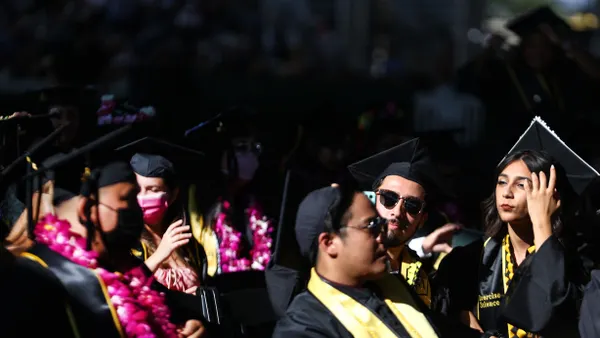Dive Brief:
- Women are less likely to enter certain college majors because they perceive potential discrimination in those fields, according to a new study from the American Education Research Journal.
- Researchers looked into perceived gender bias across 20 popular majors based on the extent to which the fields appeared to exhibit key traits like math orientation, science orientation and gender bias against women. The study surveyed 330 undergraduate students at a large southeastern university, according to a press release posted on Phys.org.
- Mapping survey results with data from 4,850 students from the National Center for Education Statistics' Educational Longitudinal Study of 2002, researchers could not support the theory women are "math-phobic" or "science-phobic." Accordingly, researchers suggested that administrators ought to consider whether the environment around and messages about certain majors or careers are feeding a perception of discrimination, as it's a larger factor in female participation.
Dive Insight:
When considering female participation in certain fields — in particular STEM professions, where women are often underrepresented — the "Larry Summers" question frequently comes up. The former Harvard president drew criticism in 2005 for suggesting that innate differences between men and women in certain subjects has led to a gender gap in the sciences. However, research points toward no differences between girls and boys when it comes to aptitude or interest in STEM fields.
For example, a 2014 study from the American Psychological Association looked at classroom performance with factors like GPA, rather than just examinations, based on 369 samples from 308 studies reflecting the grades of 538,710 boys and 595,332 girls from over 30 nations. Researchers found girls generally outperform boys throughout mandatory school across the world, and that's no different for math and science courses at earliest stages of learning.
The authors of the APA study agree with conclusions from the American Education Research Journal, writing that achievement gaps likely appear for girls in middle and high school, where girls are expected to not succeed in those subjects.
For educators as well as employers trying to reduce gender differences across STEM and other fields, advocates often suggest a number of tactics. For one, results from a recent Pew Research Center survey on perceptions of STEM difficulty suggest institutions develop partnerships across K-12 schools to encourage all young students of their ability to perform well in courses, with services like workshops, summer camps and public speaker talks.
For another, institutions can work with industry partners so that girls or underrepresented minorities can hear from employers that those places of work offer fair opportunities. Institutions also can build out the college-to-career pipeline at the same time through practical business training. Code.org CEO Hadi Partovi told Education Dive that considering women leave the tech industry at a rate 45% higher than men and the gender gap in computing jobs has widened during the last 30 years, it’s time for industry to consider what it can do to move the needle.
“Every one of these companies can work to promote role models who have diverse backgrounds to help show the younger generation examples of existing leaders in technology," he said. "The internal culture of some of these companies is famously bad on diversity issues, and people should recognize that creates a disincentive for students to get into them and stay in the field."
At the same time, while some institutions like Oxford University in the United Kingdom are taking tactics like extended exam time to target the gender gap, institution leaders and employers ought to be aware psychology experts often note initiatives feeding into a narrative of girls as a "weaker sex" may actually hinder confidence-building for women.














